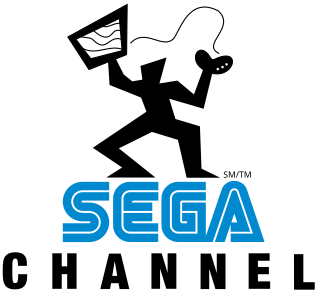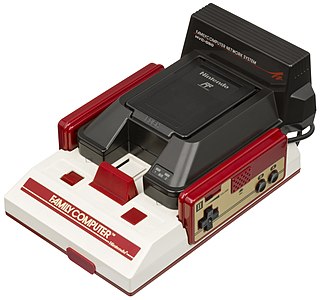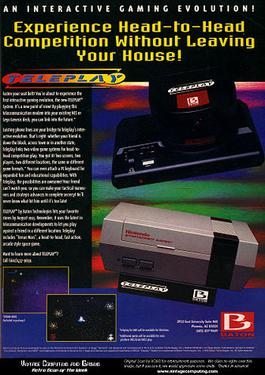
The Super Nintendo Entertainment System, commonly shortened to Super Nintendo, Super NES or SNES is a 16-bit home video game console developed by Nintendo that was released in 1990 in Japan and South Korea, 1991 in North America, 1992 in Europe and Oceania, and 1993 in South America. In Japan, it is called the Super Famicom (SFC). In South Korea, it is called the Super Comboy and was distributed by Hyundai Electronics. The system was released in Brazil on August 30, 1993, by Playtronic. Although each version is essentially the same, several forms of regional lockout prevent cartridges for one version from being used in other versions.
The video game crash of 1983 was a large-scale recession in the video game industry that occurred from 1983 to 1985, primarily in the United States. The crash was attributed to several factors, including market saturation in the number of video game consoles and available games, many of which were of poor quality, as well as waning interest in console games in favor of personal computers. Home video game revenues peaked at around $3.2 billion in 1983, then fell to around $100 million by 1985. The crash abruptly ended what is retrospectively considered the second generation of console video gaming in North America. To a lesser extent, the arcade video game market also weakened as the golden age of arcade video games came to an end.
A regional lockout is a class of digital rights management preventing the use of a certain product or service, such as multimedia or a hardware device, outside a certain region or territory. A regional lockout may be enforced through physical means, through technological means such as detecting the user's IP address or using an identifying code, or through unintentional means introduced by devices only supporting certain regional technologies.
Sega Meganet, also known as the Net Work System, was an online service for the Mega Drive in Japan and later Brazil. Utilizing dial-up Internet access, Meganet was Sega's first online multiplayer gaming service, and functioned on a pay to play basis. The system functioned through the use of a peripheral called the Mega Modem and offered several unique titles that could be downloaded, and a few could be played competitively with friends. In addition, it shared technology and equipment with more serious services such as the Mega Anser, used for banking purposes. Though the system was announced for North America under the rebranded name "Tele-Genesis", it was never released for that region. Ultimately, the Meganet service would be short-lived, lasting approximately a year before it was discontinued, but would serve as a precursor to the Sega Channel and XBAND services, as well as a predecessor to online gaming services for video game consoles. Retrospective feedback praises the attempt by Sega to introduce online gaming, but criticizes the service for its logistical issues and lack of titles.
In the history of video games, the third generation of video game consoles, commonly referred to as the 8-bit era, began on July 15, 1983, with the Japanese release of two systems: Nintendo's Family Computer and Sega's SG-1000. When the Famicom was not released outside of Japan it was remodelled and marketed as the Nintendo Entertainment System (NES). This generation marked the end of the video game crash of 1983, and a shift in the dominance of home video game manufacturers from the United States to Japan. Handheld consoles were not a major part of this generation; the Game & Watch line from Nintendo and the Milton Bradley Microvision that were sold at the time are both considered part of the previous generation due to hardware typical of the second generation.

The history of the Nintendo Entertainment System (NES) spans the 1982 development of the Family Computer, to the 1985 launch of the NES, to Nintendo's rise to global dominance based upon this platform throughout the late 1980s. The Family Computer or Famicom was developed in 1982 and launched in 1983 in Japan. Following the North American video game crash of 1983, the Famicom was adapted into the NES which was brazenly launched in North America in 1985. Transitioning the company from its arcade game history into this combined global 8-bit home video game console platform, the Famicom and NES continued to aggressively compete with the next-generation 16-bit consoles including the 1988 Sega Genesis. The platform was succeeded by the Super Famicom in 1990 and the Super Nintendo Entertainment System in 1991, but its support and production continued until 1995. Interest in the NES has been renewed by collectors and emulators, including Nintendo's own Virtual Console platform.

The Sega Channel is a discontinued online game service developed by Sega for the Sega Genesis video game console, serving as a content delivery system. Launched on December 14, 1994, the Sega Channel was provided to the public by TCI and Time Warner Cable through cable television services by way of coaxial cable. It was a pay to play service, through which customers could access Genesis games online, play game demos, and get cheat codes. Lasting until July 31, 1998, the Sega Channel operated three years after the release of Sega's next generation console, the Sega Saturn. Though criticized for its poorly timed launch and high subscription fee, the Sega Channel has been praised for its innovations in downloadable content and impact on online game services.
XBAND was one of the first competitive online console gaming networks and was available for the Genesis and Super NES. It was produced by Catapult Entertainment in Cupertino, California. It is the only modem released in America to have been officially licensed by Nintendo. It debuted in various areas of the United States in late 1994 and 1995.
PlayCable was an online service introduced in 1980 that allowed local cable television system operators to send games for the Intellivision over cable wires alongside normal television signals. Through the service, subscribers would use a device, called the PlayCable adapter, to download the games for play on their Intellivision. It was the first service that allowed users to download games for play on a video game console. PlayCable was not widely adopted, due in part to high costs for users and operators, as well as limitations of the PlayCable adapter. The service was discontinued in 1984.

A ROM cartridge, usually referred to in context simply as a cartridge, cart, or card, is a replaceable part designed to be connected to a consumer electronics device such as a home computer, video game console or, to a lesser extent, electronic musical instruments.

The Atari 2600 hardware was based on the MOS Technology 6507 chip, offering a maximum resolution of 160 x 192 pixels (NTSC), 128 colors, 128 bytes of RAM with 4 KB on cartridges. The design experienced many makeovers and revisions during its 14-year production history, from the original "heavy sixer" to the Atari 2600 Jr. at the end. The system also has many controllers and third-party peripherals.
Online games are video games played over a computer network. The evolution of these games parallels the evolution of computers and computer networking, with new technologies improving the essential functionality needed for playing video games on a remote server. Many video games have an online component, allowing players to play against or cooperatively with players across a network around the world.

The Family Computer Network System, also known as the Famicom Net System and Famicom Modem, is a peripheral for Nintendo's Family Computer video game console, and was released in September 1988 only in Japan. Predating the modern Internet, its proprietary dial-up information service accessed live stock trades, video game cheats, jokes, weather forecasts, betting on horse racing, and a small amount of downloadable content. The device uses a ROM card storage format, reminiscent to the HuCard for the TurboGrafx-16 and the Sega Card for the Master System.

The Teleplay Modem is an unreleased modem prototype for the Nintendo Entertainment System (NES) created by Keith Rupp and Nolan Bushnell, designed to eventually provide online play between NES, Sega Genesis, and Super Nintendo Entertainment System.
Bit Corporation was a Taiwanese game developer and console manufacturer.

The Nintendo Entertainment System (NES) is an 8-bit third-generation home video game console produced by Nintendo. It was first released in Japan in 1983 as the Family Computer (FC), commonly referred to as Famicom. It was redesigned to become the NES, which was released in American test markets on October 18, 1985, and was soon fully launched in North America and other countries.
In the video game industry, digital distribution is the process of delivering video game content as digital information, without the exchange or purchase of new physical media such as ROM cartridges, magnetic storage, optical discs and flash memory cards. This process has existed since the early 1980s, but it was only with network advancements in bandwidth capabilities in the early 2000s that digital distribution became more prominent as a method of selling games. Currently, the process is dominated by online distribution over broadband Internet.
Online console gaming involves connecting a console to a network over the Internet for services. Through this connection, it provides users the ability to play games with other users online, in addition to other online services.
In the video game industry, a console war describes the competition between two or more video game console manufacturers in trying to achieve better consumer sales through more advanced console technology, an improved selection of video games, and general marketing around their consoles. While console manufacturers are generally always trying to out-perform other manufacturers in sales, these console wars engage in more direct tactics to compare their offerings directly against their competitors or to disparage the competition in contrast to their own, and thus the marketing efforts have tended to escalate in back-and-forth pushes.

In the video game industry, the market for home video game consoles has frequently been segmented into generations, grouping consoles that are considered to have shared in a competitive marketspace. Since the first home consoles in 1972, there have been nine defined home console generations.







